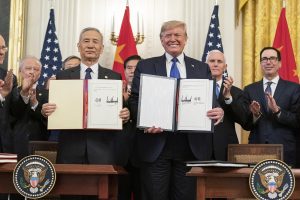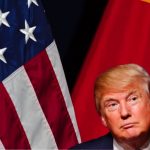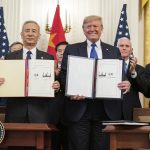Chapter By Chapter Look at Phase One Trade Agreement with China Part 2
 In the last blog, we began a chapter by chapter look at the new Phase One Trade Agreement with China. That post gave an introduction with background and looked at chapters 1-4 of the deal. Click here to read part 1 of this series.
In the last blog, we began a chapter by chapter look at the new Phase One Trade Agreement with China. That post gave an introduction with background and looked at chapters 1-4 of the deal. Click here to read part 1 of this series.
Today’s blog brings you the next phase of that series, where we look at chapters 5 and 6 of the trade deal. While the chapters looked at in the previous post largely dealt with regulations — covering things like intellectual property protections, eliminating forced transfers of technology, and removing bans on U.S. products — that should help open up Chinese markets to American businesses, and in a fairer way, the chapters covered in this part are all about money.
You’ll find out details about all that money China agreed to spend on U.S. goods you’ve probably heard about and more below.
Chapter 5 — Currency Manipulation & Devaluation
Chapter 5 is actually titled Macroeconomic Policies and Exchange Rate Matters and Transparency, which has one more “and” than I’d like it to, but that’s really of no consequence. The chapter is shorter than most of the chapters in the Phase One Trade Agreement. Perhaps that’s because it includes the following in its first article:
The Parties shall honor currency-related commitments each has undertaken in G20 communiqués, including to refrain from competitive devaluations and the targeting of exchange rates for competitive purposes.
You may recall President Trump and President Xi having dinner together in Argentina after a G20 summit just over a year ago, when the leaders called a ceasefire on the trade war. I won’t dive into the rabbit hole of tracking down all the commitments the U.S. and China have made in G20 communiqués between that and other G20 summits, but I do find the one commitment article 5.1 highlights interesting. That commitment, plus the articles that follow, show that what the U.S. is really concerned about with this chapter is China’s currency manipulation.
China is notorious for devaluing its currency. For this reason alone, I didn’t like the International Monetary Fund’s (IMF) decision back in 2015 to approve China’s renminbi as one of the world’s main central bank reserve currencies and did like Secretary of Treasury Steve Mnuchin’s move under President Trump’s direction in August to officially label China as a currency manipulator, even if the latter was just for leverage in the negotiation of this Phase One Trade Deal.
China agrees to the concession of refraining from competitive devaluations of its currency after the U.S. made the concession of removing its currency manipulator designation from China before the signing of this deal. Removing that designation is not something specifically stated in the deal; however, it may be construed as part of the first statement in this chapter that “each Party shall respect the other Party’s autonomy in monetary policy…” Or perhaps removing the designation was showing good faith in China following through with its commitment not to devalue its currency. Either way, removing the designation was likely part of a verbal agreement to get China to sign the deal. A quid pro quo, if you will.
Beyond the agreement by the parties not to manipulate currency in this chapter, regular data disclosure policies are laid out for transparency and an enforcement mechanism is put in place of bringing in the IMF if bilateral resolution can’t be reached on issues that arise.
Chapter 6 — China Will Import More U.S. Goods
This is the most talked about and famous part of the Phase One Trade Deal. Chapter 6, entitled Expanding Trade, is where China’s commitment to import an increased amount of U.S. goods can be found.
President Trump hates the trade deficit the U.S. has with China, and this is a strong step in reducing it. Here’s China’s spending commitment:
During the two-year period from January 1, 2020 through December 31, 2021, China shall ensure that purchases and imports into China from the United States of the manufactured goods, agricultural goods, energy products, and services identified in Annex 6.1 exceed the corresponding 2017 baseline amount by no less than $200 billion.
The $200 billion increase in Chinese spending on U.S. goods is broken down both by year and industry sectors.
For U.S. manufactured goods, the increase from 2017’s baseline is at least $32.9 billion in 2020 and at least $44.8 billion in 2021.
For U.S. agricultural goods, China commits to spend $12.5 billion more in 2020 and $19.5 billion more in 2021.
When it comes to U.S. energy products, China is to spend no less than $18.5 billion above the corresponding 2017 baseline in 2020 and an increase of at least $33.9 billion in 2021.
For U.S. services, China must spend at least $12.8 billion more in 2020 and $25.1 billion more than the corresponding 2017 baseline in 2021.
The spending is not supposed to end after 2021. The article later states:
The Parties project that the trajectory of increases in the amounts of manufactured goods, agricultural goods, energy products, and services purchased and imported into China from the United States will continue in calendar years 2022 through 2025.
At the end of the chapter, there’s a whole annex listing goods in each of the above specified categories.
From President Trump’s focus on the spending China agreed to when he talks about the Phase One Trade Agreement, it seems that this is the part of the deal he is most proud of. That’s not surprising as it represents a fulfillment of one of the president’s biggest campaign promises: to bring down the trade deficit the U.S. has with China. It also helps with others: increasing U.S. production and jobs.
When the article states, “The United States shall ensure to take appropriate steps to facilitate the availability of U.S. goods and services to be purchased and imported into China” it is almost like a call to action for America to increase its production of goods and services.
Conclusion So Far and Moving Forward…
This blog series will be broken into three phases with the final part, covering the last two chapters of the deal, being posted on Tuesday. Therefore, I won’t make any final conclusions until then. However, there are general observations to be made so far.
The Phase One Deal is very U.S.-friendly so far, with almost all of its articles addressing concerns the U.S. has had with China. Reading, it would seem almost all the concessions in the deal are made by China. And spoiler alert, the last two chapters that we’ll look at next time are mainly concerned with dispute resolution with a few final provisions added at the end.
The biggest concessions the U.S. has made seem to be things done outside of the Phase One Trade Agreement itself with moves like removing the official currency manipulator label from China and cancelling the last round of tariff hikes that was scheduled for December. That has to make President Trump happy as that label and those tariff hikes were only put in place to induce China to sign a trade deal in the first place. Additionally, most of the tariff hikes President Trump placed on China during this trade war remain in place.
Click here for the final part of this series, diving into chapters 7 and 8 of the Phase One Trade Deal. As for now, China is committed to buy, so, exporters, this is a good time to sell.




